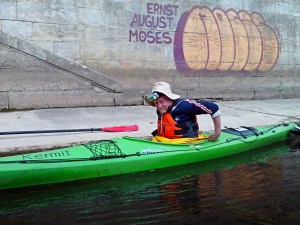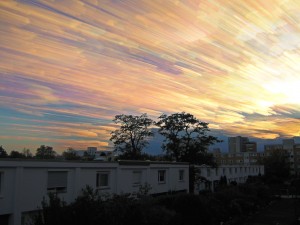After getting the kayaking under control, the next question that arose was, “How to photograph it?” I felt reminded a little of what Matt from Christchurch had said about horse riding and how it enhances viewing the countryside because you are no longer forced to look at the ground for most of the time. The horse is taking care of that. Now kayaking offers a very different landscape than most hiking because of the lack of obstacles. Nor do you really have to care where to place the paddle, and the view is mostly directed forward to the goal. True, sitting on a river means that you are at the lowest point on the landscape and much of the lower view is obstructed by the bank. But even banks can be pleasant to look at.

Some work was expended in trying to stabilise the images digitally but was rewarded with only modest success. The next strategy was to stabilise the camera and increase the shooting rate as far as possible, and then to look for some other method of digital stabilisation.
In the course of the hardware optimisation I must have bought over a dozen pieces of plastic from about as many Chinese companies who were all specialised in making imitation GoPro parts and who sent their stuff postage-free airmail from China. It would start with me thinking, “Oh, what if I had an X,” which might be anything from a screw to a suction cup fitting with an adapter for screwing the camera onto, then searching around Amazon. And it wasn’t that expensive for experimenting with in the first place. That not much of it found its way into the solution is moot.
The heart of the solution was to mount the camera as near as possible to the centre of gravity of the boat in all three dimensions, i.e. practically just in front of the (fore) cockpit. A friend offered to help out with some smooth plastic foil that could be stuck to the boat and which could be used to attach the suction cup. The surface of the boat was too scratched to keep the suction cup attached, but with the plastic surface it might have worked, only there wasn’t enough flat area for the suction cup.
I devised a catamaran-like structure which might have been attached to the bow, and would have had its own stability issues when I hit upon a workable solution to simply attach the camera directly to the deck with sticky tack. Down to the dime store for the sticky tack, stuck the camera on and secured it by tying the strap to the net and Bob’s your uncle.
On the software side it proved possible to rework one of the CHDK intervalometer scripts to allow for continuous shooting. There was a bit of an issue with the A470 losing focus in longer continuous shoots, and that could be overcome by setting the focus at infinity. Eventually the script also included all of the setting up steps to put the camera into continuous mode, and even allowing it to shoot without metering or checking the focus (which will be useful for star photography).

Finally I decided not to risk the camera completely and bought a waterproof bag. Well, the bag was waterproof to begin with, but I had to drill a hole in it so that a screw could be attached from the outside of the bag for stably mounting the camera. Put a tennis ball in the bag, screwed the screw onto a nut in the bag separated by two plastic washers and sunk it into the washing basin… No bubbles, it was still waterproof. Not designed to survive diving depths of 10 metres, but it may come out of an Eskimo roll and still work.
Then it was back to the dark room.
